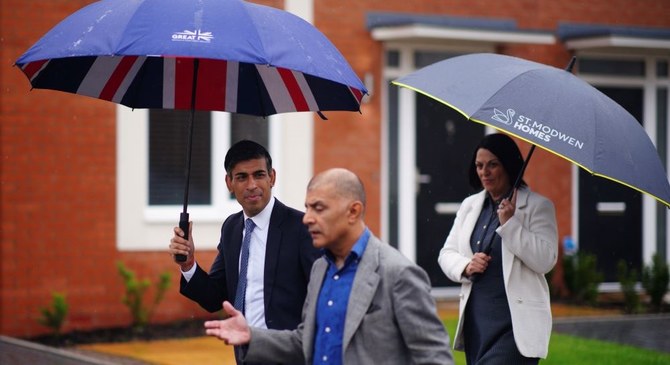
Harold Wilson was, back in the 1960s, the last UK prime minister to lose three by-elections in one day. However, fast forward about six decades and Rishi Sunak nearly repeated this ignominious feat last Thursday.
Last week’s by-election results confirm that the most likely scenario at the next UK general election, which is expected to take place next year, is a big sea change, with the Conservatives likely to lose power. Indeed, the Labour Party could have its biggest success since its landslide wins under Tony Blair in 1997 and Clement Attlee in 1945.
The big picture from the three elections was that the average drop in Conservative support was 21 percentage points. That roughly matches the 18-point fall in Conservative support that national opinion polls are currently showing.
Labour’s win in Selby and Ainsty in Yorkshire, northern England, and the Liberal Democrats’ victory in Somerton and Frome in southwest England, where the Liberals have strong support, showcase the scale of the potential Conservative losses at the next general election. Although the Conservatives won narrowly in Uxbridge and South Ruislip, Outer London, this provides little relief for Prime Minister Sunak. Even the victorious Conservative candidate Steve Tuckwell said his triumph in Uxbridge was down to a backlash over the proposed extension of the clean air zone in London, which many voters are upset about. So, it was not an endorsement of the prime minister and his five national priorities.
The Electoral Calculus prediction tool currently indicates Labour winning with a general election majority of some 300 seats. This forecast may well exaggerate the probable outcome, which would be vastly in excess of 1997 (a Labour majority of 179, when Blair became prime minister) and 1945 (a majority of 145 for Attlee). But even half the forecasted 300-seat majority would still be a big, historic victory for Labour, akin to the party’s biggest ever wins.
Thursday’s by-elections built on May’s local election results. In those ballots, the Conservatives lost more than 1,000 seats and Labour became, for the first time in more than two decades, the biggest local party in England.
It is possible that the polls will tighten in the coming months and that, while Labour will very likely win more seats than the Conservatives, the size of victory may not be on this historically epic scale. However, this would require Sunak to get over a wide range of challenges beforehand.
About three-quarters of a year into his term of office, Sunak has had a very difficult time in 10 Downing Street. He has not experienced a chain of events quite as disastrous as his predecessor Liz Truss, whose prime ministership imploded within 50 days. However, the premiership of Truss is an exceptionally low baseline from which to judge Sunak’s term. He has had some ups but a lot of downs too, including a significant number of Cabinet resignations for ethics-related reasons, including former Deputy Prime Minister Dominic Raab.
To be fair to Sunak, there have been a very small number of successes. These include the negotiation of the Windsor Framework that seeks to resolve the challenges of the post-Brexit Northern Ireland protocol that Boris Johnson negotiated.
While it is by no means certain that Labour will win an unprecedented majority at the next general election, last week’s by-elections and May’s local ballots have fueled the growing perception that the party will emerge with the largest number of MPs in Westminster. This is encouraging increasing numbers of Conservative MPs to announce their retirements from politics. Nearly 50 have now done so, including most recently Defense Secretary Ben Wallace.
A key question for the government will be whether it can regain any political momentum at all before the general election. This is possible but is made less likely because it lacks energy after almost a decade and a half of Conservative rule.
However, Sunak looks set to escape a leadership challenge and is most likely to take the party into the next election. This is, in part, because of the declining political fortunes of Johnson, who has now left parliament under a cloud and whose standing within the party has slipped.
The Labour Party could have its biggest success since its landslide wins under Tony Blair in 1997 and Clement Attlee in 1945.
Andrew Hammond
But Sunak still has a massive political hill to climb as he, like other prime ministers who took power between elections, tries to give himself time to establish himself before going to the polls. The task is so difficult for Sunak because so much of the public is skeptical of him and his government. He also knows that no party in modern UK political history has won five elections in a row, and he must try to do this in the context of a divided caucus of Conservative MPs, high inflation, increased interest rates and cuts in government spending.
So, he has a huge challenge ahead and he faces this in a context where the large number of ministers who have left office in recent years could become significant political thorns in his side. In recent weeks, for instance, Truss has been renewing her push for a radical low-tax agenda.
Taken together, this is why Labour is now likely to win the next general election, potentially in overwhelming fashion. While Sunak is likely to stay as prime minister until then, the political winds are blowing strongly against the Conservatives winning a fifth straight term of office.
Andrew Hammond is an Associate at LSE IDEAS at the London School of Economics.












